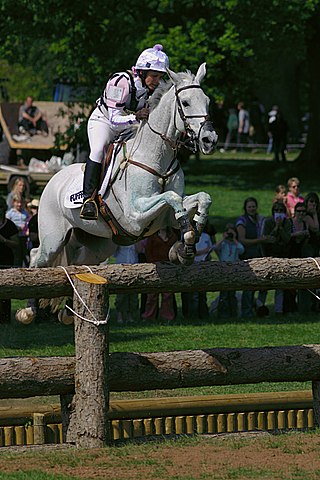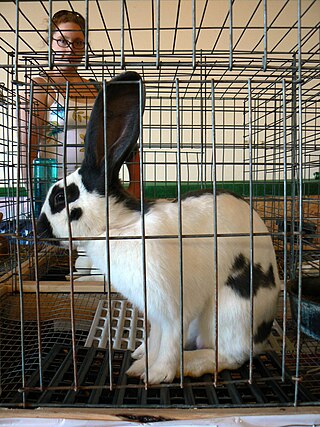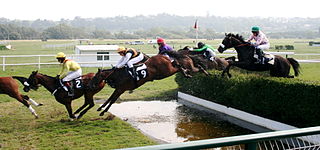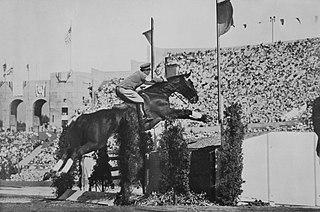Show jumping is a part of a group of English riding equestrian events that also includes eventing, hunters, and equitation. Jumping classes are commonly seen at horse shows throughout the world, including the Olympics. Sometimes shows are limited exclusively to jumpers. Sometimes jumper classes are offered in conjunction with other English-style events. Sometimes, show jumping is but one division of a very large, all-breed competition that includes a very wide variety of disciplines. Jumping classes may be governed by various national horse show sanctioning organizations, such as the United States Equestrian Federation or the British Showjumping Association. International competitions are governed by the rules of the International Federation for Equestrian Sports.

Jumping or leaping is a form of locomotion or movement in which an organism or non-living mechanical system propels itself through the air along a ballistic trajectory. Jumping can be distinguished from running, galloping and other gaits where the entire body is temporarily airborne, by the relatively long duration of the aerial phase and high angle of initial launch.

Eventing is an equestrian event where a single horse and rider combine and compete against other competitors across the three disciplines of dressage, cross-country, and show jumping. This event has its roots in a comprehensive cavalry test that required mastery of several types of riding. The competition may be run as a one-day event (ODE), where all three events are completed in one day or a three-day event (3DE), which is more commonly now run over four days, with dressage on the first two days, followed by cross-country the next day and then show jumping in reverse order on the final day. Eventing was previously known as Combined Training, and the name persists in many smaller organizations. The term "Combined Training" is sometimes confused with the term "Combined Test", which refers to a combination of just two of the phases, most commonly dressage and show jumping.

Cross country equestrian jumping forms one of the three phases of the sport of eventing; it may also be a competition in its own right, known as hunter trials or simply "cross-country", although these tend to be lower-level, local competitions.

The American Rabbit Breeders Association (ARBA) is a national club for domestic rabbit and cavy breeders. The ARBA is headquartered in Knox, Pennsylvania in the United States. Its membership is composed of rabbit and cavy exhibitors, commercial breeders, and pet owners in North America and many countries throughout the world.

The equestrian program at the 1912 Summer Olympics in Stockholm, included five medal events. There were individual competitions in dressage, eventing, and show jumping. Team scores were also gathered and medals awarded for teams in the eventing and jumping competitions. Equestrian had been absent from the Olympic program since the 1900 Summer Olympics, making the 1912 Games the second time the sport was featured. Ten nations competed: Belgium, Chile, Denmark, France, Germany, Great Britain, Norway, Russia, Sweden, and the USA. Only Sweden and Germany were able to supply a full team for all three disciplines, with several countries having several riders and horses used in two or even all three disciplines. A total of 88 entries ran in the three events, with 62 riders and 70 horses.

The Mini Lop is a breed of domestic rabbit that is recognized by the American Rabbit Breeders Association (ARBA). It is different from the Miniature Lop breed that is recognized by the British Rabbit Council (BRC). The Mini Lop [US] and the Miniature Lop [UK] are different from the Dwarf Lop breed that is recognized by the BRC. The Mini Lop is similar to several other small rabbit breeds, such as the Dwarf rabbit.

Equestrian sports were first included in the Olympic Games in the Summer Olympics of 1900 in Paris. They were again included in 1912, and have been included in every subsequent edition of the Games. The Olympic equestrian disciplines are dressage, eventing, and show-jumping. In each discipline, both individual and team medals are awarded. Women and men compete on equal terms.

A steeplechase is a distance horse race in which competitors are required to jump diverse fence and ditch obstacles. Steeplechasing is primarily conducted in Ireland, the United Kingdom, Canada, United States, Australia, and France. The name is derived from early races in which orientation of the course was by reference to a church steeple, jumping fences and ditches and generally traversing the many intervening obstacles in the countryside.
Loro Piana TomBoy VI was a horse ridden by Rodrigo Pessoa in international show jumping competition. The powerful grand prix showjumper was notable for his unusual jumping style, which saw him loosely dangle his front legs while jumping, thus necessitating that he clear the obstacles with several feet of extra "air". Tomboy managed to clear the jumps as well or even better than his competitors. He stood 17.0 hh. He died in 2014 at the age of 31.

Rat agility is a sport for pet rats. It basically uses scaled down versions of the obstacles used for dog agility. The sport originated in Sweden and can trace its origin back to table runs in the 1980s. It became an official competition in 2000.

Dog agility is a dog sport in which a handler directs a dog through an obstacle course in a race for both time and accuracy. Dogs run off leash with no food or toys as incentives, and the handler can touch neither dog nor obstacles. The handler's controls are limited to voice, movement, and various body signals, requiring exceptional training of the animal and coordination of the handler.

Cavaletti are small jumps, originally made of wood, used for basic horse training. Most consist of rails that are about 4 inches (10 cm) wide, and 10 feet (3.0 m) long. The rails are inserted into fixed standards, usually made in an "X" shape, that commonly are designed to be placed at one of three preset heights ranging from a few inches off the ground to a maximum of about 18 to 24 inches. However, in informal terminology, even ground rails without standards are sometimes called "cavaletti." Modern designs can be made from various types of molded plastic and PVC pipe as well as wood. They can be used both for ground training with the handler working a horse on a longe line or at liberty, or while a rider is mounted on the horse. Cavaletti are used by practitioners of both English riding and western riding. Similar obstacles of lighter weight materials are used with dogs in dog agility and canine physical therapy.
Equine agility or horse agility is a sport similar to dog agility but using horses. Horses are asked to navigate an obstacle course with guidance from a human handler on the ground. At lower levels, the horse may be guided with a lead rope but at higher levels the horse works without a lead and in some cases, without a halter. There also are competition levels where horses compete in the "wild" — outside of an enclosed arena, and competitions where horses are not judged live but rather via video sent in by their handlers. Any equine of any size may compete in agility, including miniature horses, donkeys, mules and draft horses.

The individual show jumping in equestrian at the 1932 Summer Olympics in Los Angeles was held on 14 August. The event was called the "Prix des Nations" at the time. There were 14 competitors from 4 nations.

The individual show jumping event at the 2020 Summer Olympics is scheduled to take place on 3–4 August 2021 at the Baji Koen. Like all other equestrian events, the jumping competition is mixed gender, with both male and female athletes competing in the same division. 75 riders from 35 nations are expected to compete.

The team show jumping event at the 2020 Summer Olympics took place on 6–7 August 2021 at the Baji Koen. Like all other equestrian events, the jumping competition was open-gender, with both male and female athletes competing in the same division. 60 riders from 20 nations competed. The event was won by team Sweden, which included Peder Fredricson, the silver medalist in the individual event. The United states were second, and Belgium third.
















